 The Goddess has always been a huge believer in sampling local products and cuisine. She was there long before it became a “thing”. But, she’s darned glad it did become a thing. To that end, she found some Muscadine grapes at the Farmer’s Market. They are pretty much a wild grape, that’s indigenous to the Southern part of the US, in particular North Carolina. So she bought herself some and made preserves.
The Goddess has always been a huge believer in sampling local products and cuisine. She was there long before it became a “thing”. But, she’s darned glad it did become a thing. To that end, she found some Muscadine grapes at the Farmer’s Market. They are pretty much a wild grape, that’s indigenous to the Southern part of the US, in particular North Carolina. So she bought herself some and made preserves.  These are the blackish purple variety. And they are huge…I’m talking ping-pong ball-sized.
These are the blackish purple variety. And they are huge…I’m talking ping-pong ball-sized. 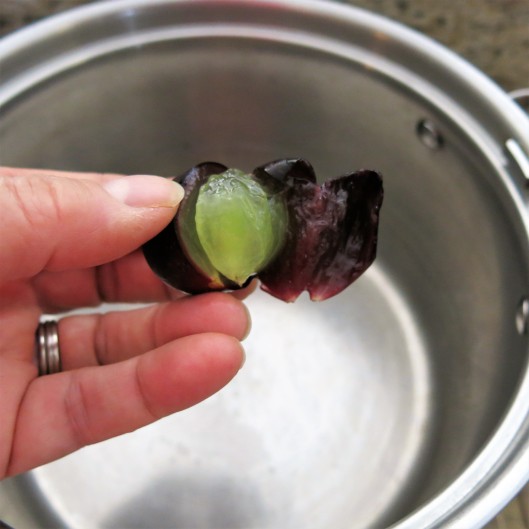 They have a really, really tough skin, a gelatinous green pulp,
They have a really, really tough skin, a gelatinous green pulp, 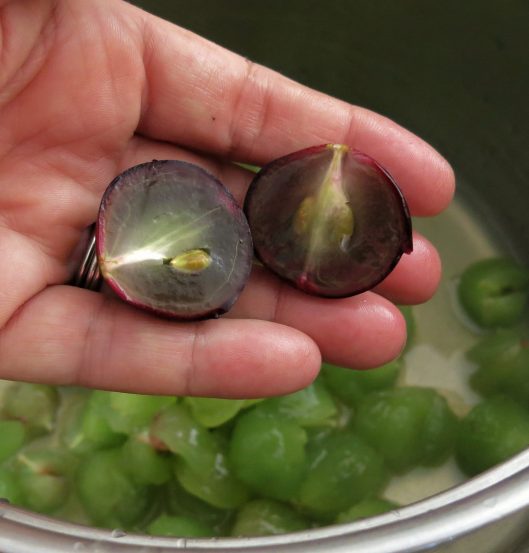 and two to four seeds. They are, by the way, delicious to eat as is. When I tell you the skin, is tough, I’m not just a kiddin’! Nothing at all like the grapes we’re used to, not even Concord grapes, which the flavor reminds me of. There is another variety of Muscadine grapes called Scuppernong! Isn’t that a great word? They are usually either green or bronze and are so-named because they were discovered near the Scuppernong River, here in North Carolina. Apparently, the original mother vine is on Roanoke Island. I guess it’s been growing and producing for several hundred years. These are tough grapes, disease resistant, more round than oblate, and prolific as can be. They don’t ripen all at once, in bunches, like other grapes, but rather in clusters. And, the vendor at the Farmer’s Market told me that lots of people make wine from them…imagine that! Next year, maybe….
and two to four seeds. They are, by the way, delicious to eat as is. When I tell you the skin, is tough, I’m not just a kiddin’! Nothing at all like the grapes we’re used to, not even Concord grapes, which the flavor reminds me of. There is another variety of Muscadine grapes called Scuppernong! Isn’t that a great word? They are usually either green or bronze and are so-named because they were discovered near the Scuppernong River, here in North Carolina. Apparently, the original mother vine is on Roanoke Island. I guess it’s been growing and producing for several hundred years. These are tough grapes, disease resistant, more round than oblate, and prolific as can be. They don’t ripen all at once, in bunches, like other grapes, but rather in clusters. And, the vendor at the Farmer’s Market told me that lots of people make wine from them…imagine that! Next year, maybe….
I’m writing this up while the jars are in the hot water bath.  To begin, we slit each grape,
To begin, we slit each grape, 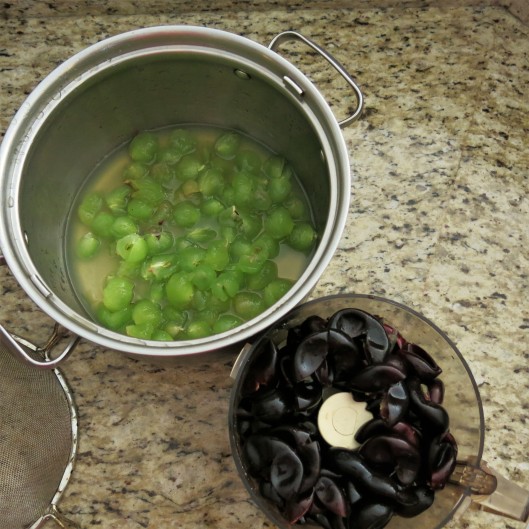 pop the pulp into a large pot and remove the skins to the food processor bowl.
pop the pulp into a large pot and remove the skins to the food processor bowl. 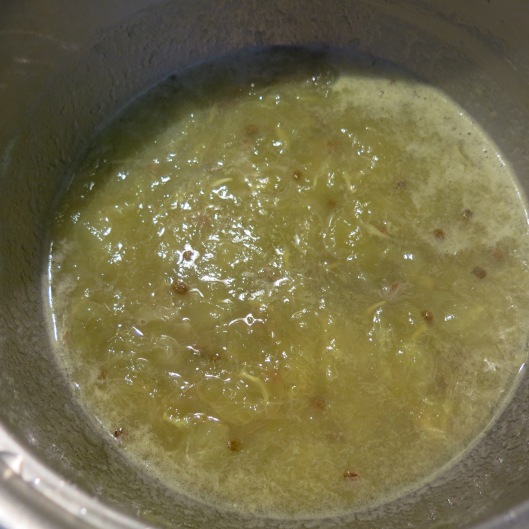 We boil the pulp down, with 1/2 cup water, about 15 minutes. You want them to be soft and mushy,
We boil the pulp down, with 1/2 cup water, about 15 minutes. You want them to be soft and mushy,
so they can be pushed through a single mesh strainer (or a food mill), to remove the seeds. Once you have the now seedless pulp back in your large pot, whirl up those skins. 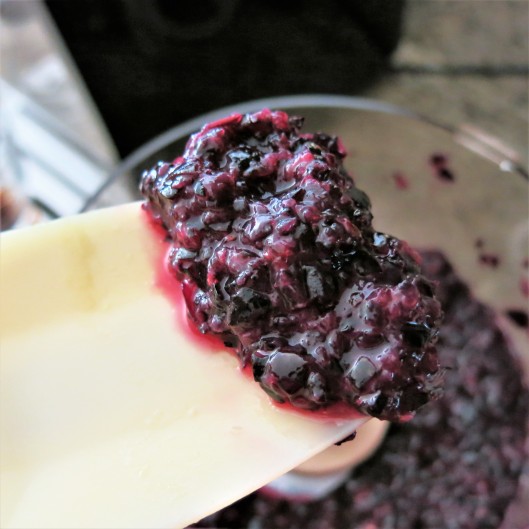 You want them to be pretty small, because we’re going to simmer the bits with the pulp until they are a bit more tender.
You want them to be pretty small, because we’re going to simmer the bits with the pulp until they are a bit more tender. 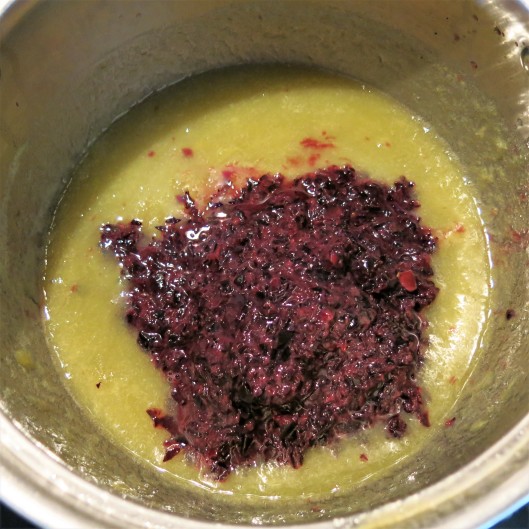 Add the remaining 1 cup of water and the lemon juice. Simmer for about 20 minutes.
Add the remaining 1 cup of water and the lemon juice. Simmer for about 20 minutes.
Stir the pectin and salt into 1/4 cup sugar and add it all at once to the simmering fruit and skins.
Return to the boil and boil 1 minute. Then, add the remaining cup of sugar, and stir the mixture to make certain there aren’t lumps. 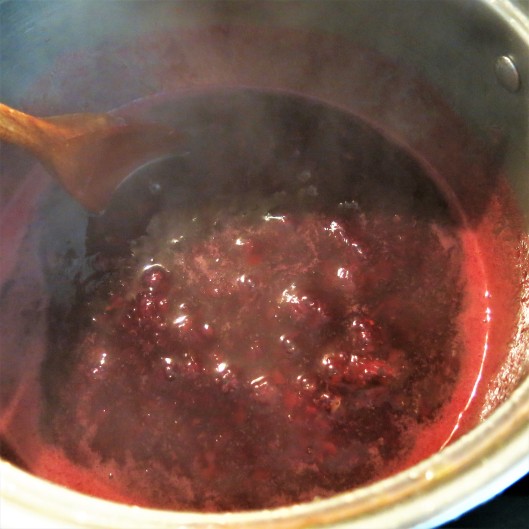 Return to the boil and boil hard for 1 minute. This should be a boil you can’t stir down. Remove from the heat source (..oh, fun! The first jar just pinged! It’s sealed. I love that sound! There’s the second one!), let stand for a minute or two and ladle into jars. I use wide-mouth half-pint (8 ounce) or quarter pint (4 ounce) jars for jams and preserves. They are a nice size of giving as gifts, as well. Wipe the rims with a squeaky clean cloth, place the lids (there goes the third jar!) and rings on and tighten.
Return to the boil and boil hard for 1 minute. This should be a boil you can’t stir down. Remove from the heat source (..oh, fun! The first jar just pinged! It’s sealed. I love that sound! There’s the second one!), let stand for a minute or two and ladle into jars. I use wide-mouth half-pint (8 ounce) or quarter pint (4 ounce) jars for jams and preserves. They are a nice size of giving as gifts, as well. Wipe the rims with a squeaky clean cloth, place the lids (there goes the third jar!) and rings on and tighten.  Place on a rack, in a pot of boiling water. Boil for 10 minutes. Turn off and carefully remove
Place on a rack, in a pot of boiling water. Boil for 10 minutes. Turn off and carefully remove  the jars to cool completely. Now, you can store these for at least one year, in a cool, dark place.
the jars to cool completely. Now, you can store these for at least one year, in a cool, dark place.
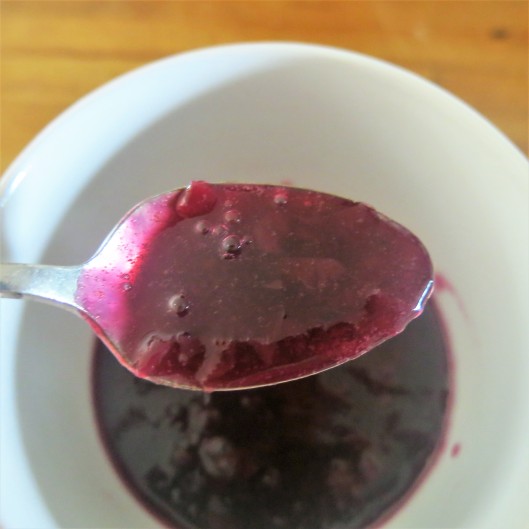 The consistency of this is exactly what I wanted it to be. I’m not fond of stiff preserves. We’ve all experienced jams and preserves that you have to pry out of the bottle, and crush and tear the bread. To avoid that, I only use a small amount of the low-sugar pectin (there’s the fourth and last jar!). I usually find that when I follow the amount suggested, the consistency is way too thick for my taste. But, that’s a personal thing.
The consistency of this is exactly what I wanted it to be. I’m not fond of stiff preserves. We’ve all experienced jams and preserves that you have to pry out of the bottle, and crush and tear the bread. To avoid that, I only use a small amount of the low-sugar pectin (there’s the fourth and last jar!). I usually find that when I follow the amount suggested, the consistency is way too thick for my taste. But, that’s a personal thing.
Muscadine Grape Preserves
Excellent on toast, English muffins, with cheese, or as a glaze for chicken, pork or fish.
- 2 pounds Muscadine grapes (some really some, some firm), washed
- 1 1/2 cups water, divided
- 3 tablespoons lemon juice
- 1 1/4 cups sugar, divided
- 1 1/2 teaspoons low-sugar pectin
- Large pinch kosher salt
- Large, deep pot with hot water and a rack
- 5 half-pint canning jars with rings and lids
Get out a large, deep heavy-bottomed pot. Slit one side of each grape, and pop the pulp out of the skin by squeezing gently. They are juicy, so it’s less messy if you do the squeezing near the bottom of the pot. Place the skins in the bowl of a food processor (or blender—and immersion blender doesn’t work as well, as it doesn’t “grind” the skins up enough). When you have the pulp and the skins separated, place the pot with the pulp on the burner, add 1/2 cup water and bring to the boil. Boil gently for about 15 minutes, until the pulp is soft and mushy. Pour the pulp int a single mesh strainer, and using a metal spoon, rub it through until you have only seeds left (there will be a little pulp, but not much. You may do this with a food mill, too. Once you have the now seedless pulp back in your large pot, whirl the skins in the food processor for a couple of minutes. You want the skins to be in pretty small pieces or they will be too chewy. Add the finely ground skins, the remaining 1 cup of water and the lemon juice to the pot. Simmer for about 20 minutes, or until the skins have lost their “crunch”! Stir the pectin and salt into 1/4 cup sugar. Add it all at once to the simmering fruit and skins, stirring constantly to prevent lumps. Return the mixture to the boil; boil 1 minute. Add the remaining cup of sugar, return to the boil and boil hard (a boil you can’t stir down!) for 1 minute. Remove the pot from the heat source, let stand for a minute or two and ladle into jars. Wipe the rims with a squeaky clean cloth, place the lids and rings on the jars and tighten. Don’t over tighten though. Place the jars, on a rack, in a pot of boiling water that will cover the jars by at least one inch. Boil for 10 minutes. Turn off and carefully remove the jars to cool completely. The preserves can be stored for at least one year. Serve with toast, scones, on a cheese tray, or use as a glaze for pork, chicken or fish.
Muscadine Grape Preserve Recipe©Marcia Lahens 2018. All rights reserved.
I know this isn’t going to be something most of my clever readers will make, but I thought I would share anyway. You just never know, you might find yourself in North Carolina in September! Besides, this recipe could absolutely be used with Concord grapes.

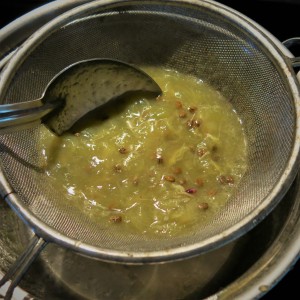
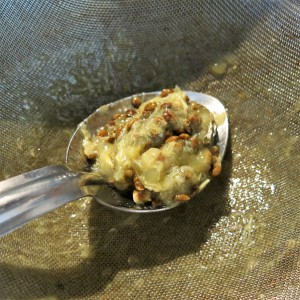
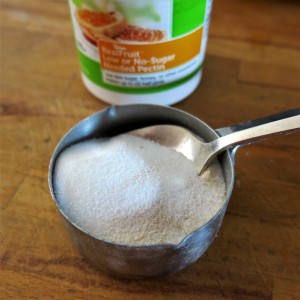


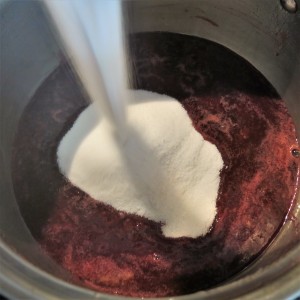
Thank you for the recipe. I just picked a huge bucket of muscadines, and ate just as many, for my first batch of jelly/preserves.
LikeLike
If I want my preserves thick how much more low sugar pectin? I have a Weston fruit strainer so I can seperate the seeds from the grape without the heating up with water part. Wondered how I should do it different . If I need to cook the processed skins, juice and pulp longer together. Glad I could finally find a recipe that included pulp and skins with low sugar recipe.
LikeLike
Denise, I’m so happy you’re making muscadine preserves and thanks for reaching out. It’s great that you can use your Weston strainer; that will save time, you’ll be able to skip the initial cooking. Remove the skins first and then run the pulp through the strainer. You will need to either grind the skins or use the food processor. You want them in very, very small pieces, as they are rather tough. But, they will break down enough during cooking. If you want the mixture thicker, and you’re following this recipe, then I would increase the pectin amount to perhaps 2-3 tablespoons. But, I am giving you an educated guess here. I detest over-set preserves, so I always err on the side of softer. You will definitely need to cook the pulp and skins together and I would add some water, as well. I wish I could be more helpful, but as a fallback, you could probably just follow the proportional recipe for Concord grape preserves that comes with the low-sugar pectin package. As I said, I wish could be more helpful and if this isn’t clear, don’t hesitate to reach out again. Good luck and please let me know how it worked out.
LikeLike